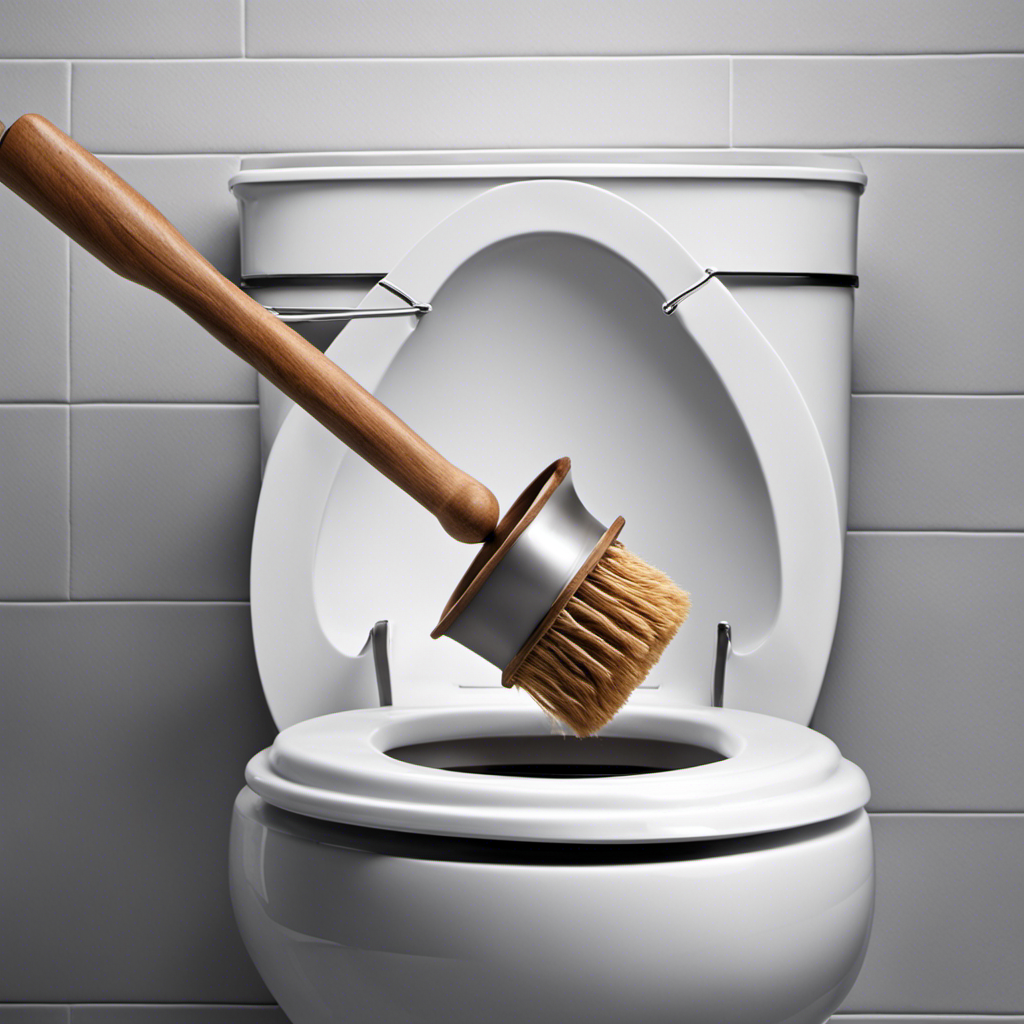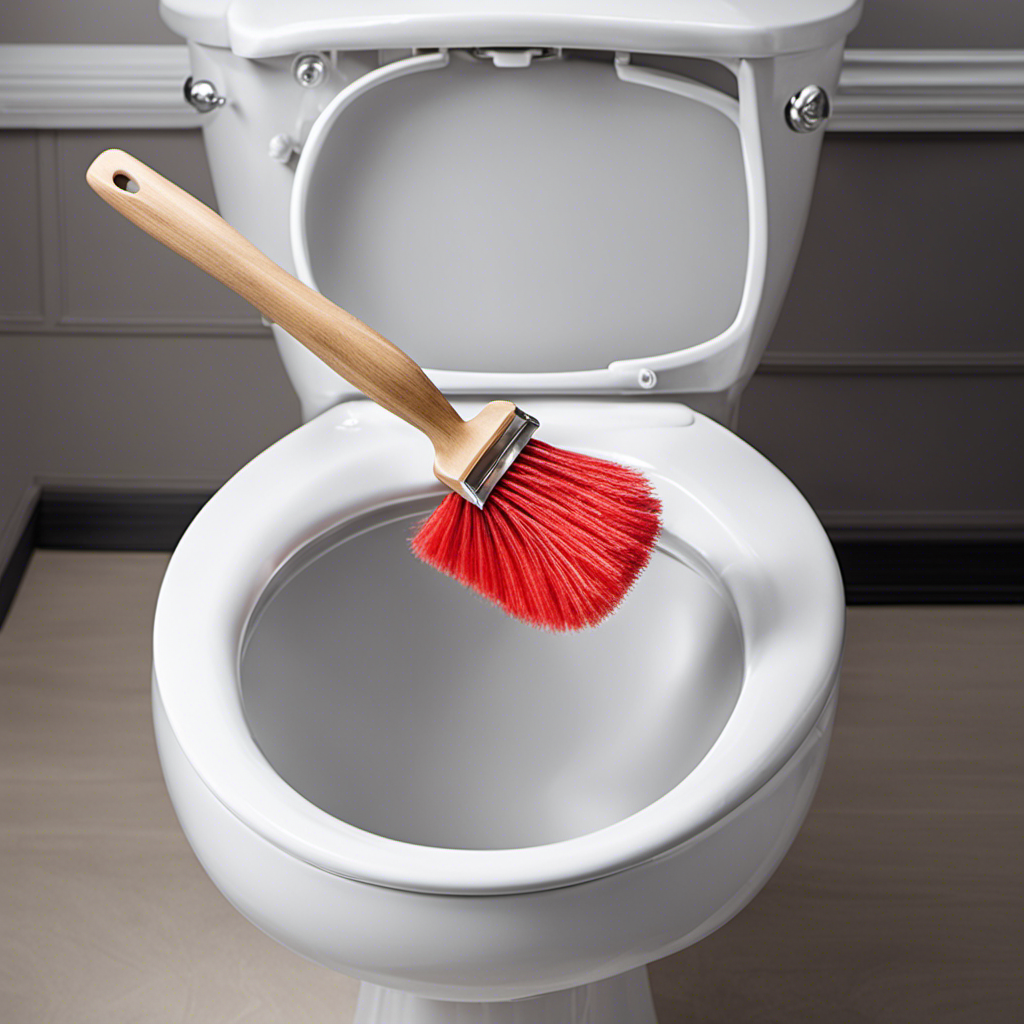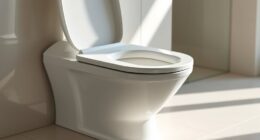As someone who’s had their fair share of toilet troubles, I know how frustrating it can be to deal with a clogged toilet. But fear not! In this article, I’ll guide you through the steps to unclog a toilet with ease.
From common causes of clogs to the tools and materials you’ll need, I’ll provide detailed instructions to help you become a toilet unclogging pro.
So, let’s roll up our sleeves and get ready to tackle that stubborn clog!
Key Takeaways
- Flushing excessive toilet paper and items like wet wipes and feminine hygiene products can lead to toilet clogs.
- Promptly addressing clogs can prevent further damage.
- Using tools like a plunger, hot water, and a toilet auger can help unclog a toilet.
- Being mindful of what you flush down the toilet and regularly cleaning the toilet can help prevent clogs.
Common Causes of Toilet Clogs
One common cause of toilet clogs is when you flush too much toilet paper at once. While it may be tempting to use a generous amount, it is important to remember that toilets are designed to handle a certain amount of paper at a time. Excessive flushing can lead to a buildup of paper in the pipes, resulting in a clog.
To prevent toilet clogs, it is recommended to only flush a reasonable amount of toilet paper. Additionally, it is important to be mindful of what you flush down the toilet. Items such as wet wipes, feminine hygiene products, and excessive amounts of toilet paper can contribute to clogs.
Signs of a severe toilet clog include water backing up into the bowl, slow drainage, and gurgling sounds. If you notice these signs, it is best to address the issue promptly to prevent further damage.
Tools and Materials Needed for Unclogging a Toilet
To unclog a toilet, you’ll need a plunger and a bucket. The plunger is a simple yet effective tool for loosening and dislodging clogs. Make sure the plunger has a rubber suction cup at the end, as this creates a tight seal around the toilet drain.
Fill the bucket with hot water, but not boiling, and pour it into the toilet bowl. This helps to soften and break down the clog.
Next, place the plunger over the drain hole and firmly push down, then pull up rapidly. Repeat this motion several times until the water begins to drain.
If the plunger doesn’t work, you can try using a drain snake. A drain snake is a long, flexible tool that can reach deep into the toilet drain to dislodge stubborn clogs. Insert the snake into the drain and rotate it while pushing it further in until you encounter resistance.
Once you’ve reached the clog, rotate the snake to break it up and then pull it out. Remember to always wear gloves and follow safety precautions when using a drain snake.
Step-by-Step Guide to Unclogging a Toilet
Start by gathering the necessary tools and materials for unclogging a toilet, such as a plunger and a bucket. Unclogging a toilet can be a messy and unpleasant task, but with some DIY techniques, you can save yourself the hassle and expense of calling a plumber.
To prevent toilet clogs in the future, it’s important to be mindful of what you flush down the toilet. Avoid flushing items like wipes, feminine hygiene products, or excessive amounts of toilet paper.
Now, let’s move on to the step-by-step guide to unclogging a toilet:
-
Prepare the area: Lay down towels or newspaper to protect the floor from any potential spills or splashes.
-
Use a plunger: Place the plunger over the drain hole and push down firmly, then pull up quickly. Repeat this motion several times until the water starts to drain.
-
Check the trap: If plunging doesn’t work, you may need to check the trap. Using a toilet auger or a wire coat hanger, gently push it into the drain hole and rotate it to dislodge the clog.
-
Flush and clean: Once the water starts to drain, flush the toilet to ensure the clog is completely cleared. Finally, clean the toilet bowl and surrounding area with a disinfectant.
Tips and Tricks for Preventing Toilet Clogs
If you want to prevent toilet clogs, make sure to be mindful of what you flush down the toilet. Proper toilet maintenance is essential in preventing plumbing issues and avoiding the hassle of unclogging a toilet.
First and foremost, remember that toilets are designed to handle human waste and toilet paper. Anything else, such as feminine hygiene products, wipes, or paper towels, should never be flushed down the toilet. Additionally, it is important to avoid excessive toilet paper usage, as using too much can lead to clogs.
Regularly cleaning your toilet and using a plunger to remove minor clogs can also help maintain a clear and functioning toilet. By following these tips and tricks, you can greatly reduce the chances of experiencing a clogged toilet and the need for professional assistance.
When to call a professional for toilet clog assistance is an important consideration.
When to Call a Professional for Toilet Clog Assistance
Knowing when it’s necessary to reach out to a professional for assistance with a toilet clog is crucial. While many minor clogs can be resolved using simple DIY methods, there are certain signs that indicate a severe clog that requires professional intervention.
One of the most obvious signs is when multiple attempts to unclog the toilet using a plunger or a toilet auger are unsuccessful. Another sign is if the water level in the toilet bowl continues to rise even after flushing. This could indicate a blockage in the main sewer line, which requires specialized equipment to fix.
Before calling a professional, it’s important to try some DIY methods first, such as using a toilet plunger or a mixture of baking soda and vinegar. However, if these methods don’t work or if you notice any of the aforementioned signs, it’s time to seek professional help to avoid further damage.
Frequently Asked Questions
Can I Use a Plunger to Unclog a Toilet?
Yes, you can use a plunger to unclog a toilet. It’s a simple and effective method. However, if the plunger doesn’t work, there are alternative methods like using a toilet auger or a chemical drain cleaner.
What Should I Do if a Foreign Object Is Causing the Clog?
If a foreign object is causing the clog, I recommend using a toilet auger. It’s a flexible tool designed to break up and remove stubborn obstructions. If that doesn’t work, it’s best to call a plumber for assistance.
How Do I Know if the Clog Is in the Toilet or in the Main Sewer Line?
When dealing with a toilet clog, it’s important to determine if it’s in the toilet or the main sewer line. Signs of a main line clog include multiple fixtures backing up simultaneously.
Is It Safe to Use Chemical Drain Cleaners to Unclog a Toilet?
Using chemical drain cleaners to unclog a toilet can be risky. There are alternative methods, such as using a plunger or a toilet auger, which are safer and more effective in clearing clogs without damaging your pipes.
How Long Should I Wait Before Calling a Professional if My Attempts to Unclog the Toilet Are Unsuccessful?
When should I seek professional help for a clogged toilet? If my attempts fail, I’d wait no more than a day before calling a plumber. There are alternative methods to try, but don’t let it become a "toilet disaster"!
Conclusion
After successfully unclogging my toilet using the step-by-step guide and necessary tools, I couldn’t help but ponder the hidden meaning behind this mundane task.
Just like the clogged toilet, our lives can sometimes feel overwhelmed and blocked. But with the right knowledge and tools, we can overcome any obstacle and restore the flow.
Remember to take preventive measures to avoid future clogs, but don’t hesitate to seek professional assistance when needed.
Let this toilet unclogging experience serve as a reminder that we have the power to overcome challenges and keep life flowing smoothly.










